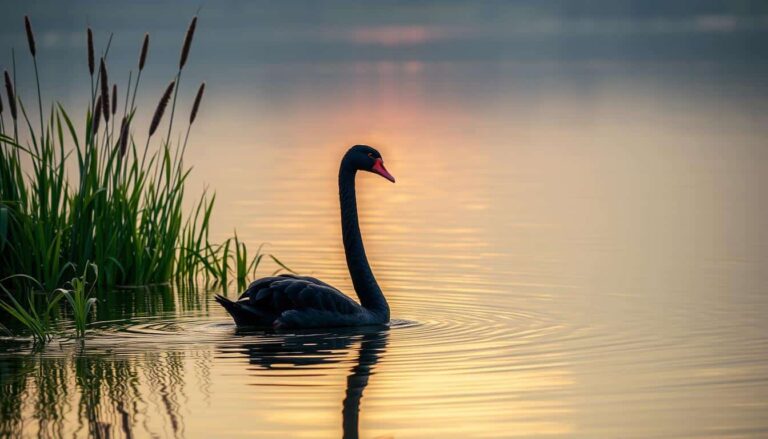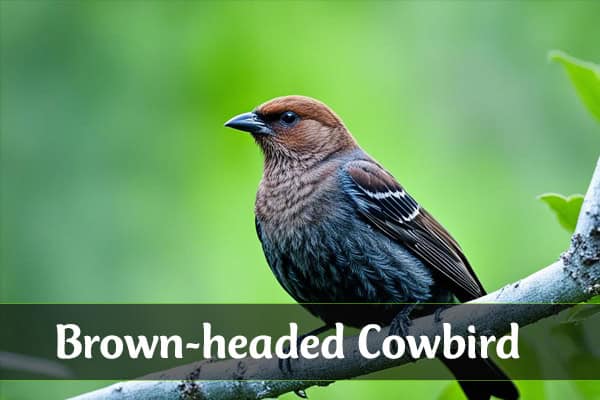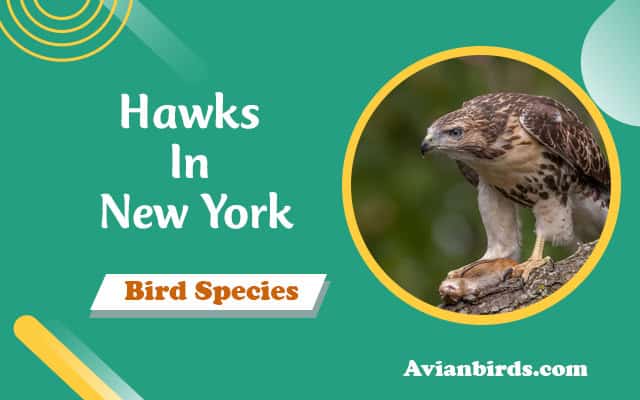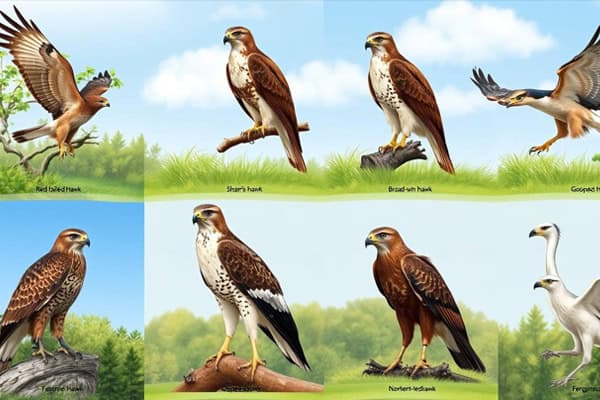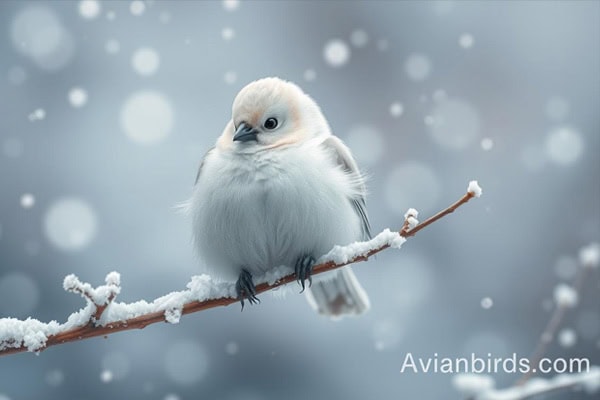5 Types of Black Birds With Orange Wings (With Pictures)
Did you know over 20% of North America’s birds have black and orange colors Wings? This fact shows how colorful our birdlife is. We’ll look at nine special black birds with orange wings in this guide. We’ll cover their unique traits, where they live, and what they do. Plus, we’ll include high-quality images to help you identify them.
Learning about these black birds makes us appreciate nature more. It also helps us see how important they are to our ecosystems.
What Makes Black Birds With Orange Wings Unique
Black birds with orange wings catch our eye with their amazing traits. Their color and patterns stand out. The bright orange on their black feathers comes from carotenoid pigments in their food. These pigments are key to their stunning colors.
The mix of black and orange makes them very noticeable and attractive in nature.
Coloration and Patterns
Their colors do more than just look good. They play a big role in their lives. For example, their bright feathers help them find a mate during mating season. These colors are important signals of health and fitness.
This helps them attract the right mate.
Behavioral Traits
These birds are also interesting to watch because of their behavior. In the spring, they show off in groups. Males do special dances to get the attention of females. This shows off their bright feathers.
These behaviors help them fit in with their group and survive. Watching them, we see how their looks and actions are key to their lives.
Common Types of Black Birds With Orange Wings
Spotting common black birds with orange wings is exciting for bird lovers. These birds show off bright colors and unique behaviors. We’ll look at different species, focusing on the orange-winged blackbirds.
Here’s a quick look at some well-known species:
| Species Name | Description | Habitat |
|---|---|---|
| Red-winged Blackbird | Known for its bright red and yellow shoulder patches. | Wetlands, marshes, and open fields. |
| Baltimore Oriole | Has striking orange plumage and black wings. | Orchards, gardens, and wooded areas. |
| Altamira Oriole | Known for its vivid orange body and deep black wings. | Riparian zones and open woodlands. |
| California Bicolored Blackbird | Has a unique bicolor look, with orange-yellow shoulder patches. | Marshes and agricultural areas. |
This guide helps us learn about these birds’ habitats and unique traits. It makes spotting them on our birdwatching trips easier. Whether we’re in wetlands or woodlands, seeing these birds is a chance to enjoy their beauty.
1. Red-winged Blackbird
- Scientific Name: Agelaius phoeniceus
- Size: 19–23 cm (7.5–9 in)
- Weight: 40–77 g (1.4–2.7 oz)
- Lifespan: 2–5 years (up to 15 years in the wild)
- Diet: Seeds, insects, and grains; often forages in wetlands
The Red-winged Blackbird is a bird that catches our eye with its bright colors and smart ways. It lives mainly in wetlands and marshes, which are key for its life and breeding. These places are not just homes but also offer food and space for raising young birds.
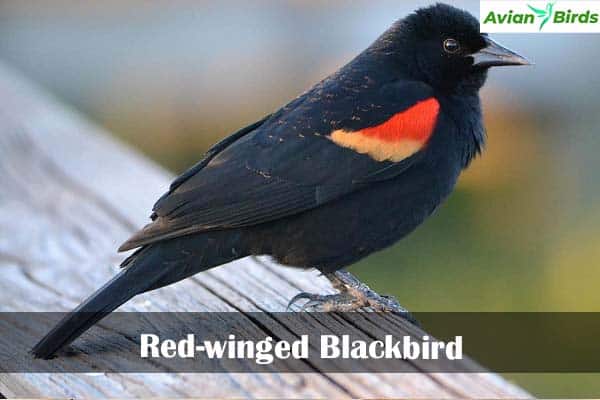
Breeding Male Characteristics
Breeding males of the Red-winged Blackbird stand out with their bright red shoulder patches. These patches show they are strong and help keep rivals away. They are important for defending their territory and drawing in females, showing off their health and strength.
Female Appearance and Behavior
Female Red-winged Blackbirds look different from the males, with duller colors and streaks. This helps them hide while they nest and take care of their babies. They pick nesting spots with good cover and food. They also forage for insects and seeds, feeding themselves and their young.
2. Bicolored Blackbird
- Scientific Name: Agelaius bi-color
- Size: 20–24 cm (7.9–9.4 in)
- Weight: 60–100 g (2.1–3.5 oz)
- Lifespan: 5–10 years
- Diet: Seeds, grains, and insects; often found in marshes and grasslands.
The California Bicolored Blackbird is unique because of its special looks and where it lives. It’s often seen near the coast, in marshes and wetlands. These places are key to its survival.

What makes this bird stand out is its bright and shiny feathers. The males have a mix of glossy black and bright red. This bright look helps them show off during mating and defend their territory.
These birds like to live together in big groups. They choose to nest in thick reed beds. This helps them stay safe from predators and protect their babies.
This bird has adapted to live in certain places. Knowing where they live helps us protect them. This way, they can keep living in their natural homes.
3. Altamira Oriole
- Scientific Name: Icterus gularis
- Size: 25–28 cm (9.8–11 in)
- Weight: 50–75 g (1.8–2.6 oz)
- Lifespan: 4–8 years
- Diet: Fruits, nectar, and insects; builds hanging nests in trees.
The Altamira Oriole is a bird that catches the eye with its bright colors and friendly nature. It lives in many places, showing interesting things about its eating habits, how it moves, and the sounds it makes.

Diet and Migration Patterns
The Altamira Oriole eats mostly insects, nectar, and fruits. This varied diet helps it survive in its home. When it moves, it doesn’t go very far. Some birds go south when it gets cold, but others stay where they are all year.
This way, they can use the best resources at different times of the year.
Vocalizations and Social Behavior
The Altamira Oriole makes beautiful sounds that help it mark its territory and talk to other birds. When they are together, their songs make the air come alive. Watching them interact shows how close they are to each other.
4. Baltimore Oriole
- Scientific Name: Icterus galbula
- Size: 25–28 cm (9.8–11 in)
- Weight: 40–50 g (1.4–1.8 oz)
- Lifespan: 2–5 years (up to 11 years in the wild)
- Diet: Fruits, nectar, and insects; attracted to feeders with orange halves.
The Baltimore Oriole is a stunning bird with bright orange and black feathers. It’s a favorite among birdwatchers in the eastern United States. This bird is not just beautiful; it’s also crucial to its ecosystem.

These birds eat insects, fruits, and nectar, fitting their active lifestyle. They often visit gardens and feeders, bringing joy to wildlife lovers.
Their nests are a marvel. They make hanging nests in deciduous trees. These nests are safe for their babies, keeping them away from predators.
When they breed, Baltimore Orioles become more social. They sing sweet melodies during courtship. Their migration shows their strength as they travel far to return home.
The Baltimore Oriole is known for its beauty and interesting ways. Its unique nesting habits make it a cherished bird in the eastern United States.
5. Black-headed Grosbeak
- Scientific Name: Pheucticus melanocephalus
- Size: 20–25 cm (7.9–9.8 in)
- Weight: 30–50 g (1.1–1.8 oz)
- Lifespan: 2–5 years
- Diet: Seeds, fruits, and insects; known for their distinctive songs.
The Black-headed Grosbeak is a bird that catches the eye with its bright colors and sweet songs. Learning about its home and how it interacts with people makes us appreciate it more.

Habitat Preferences
This bird loves living in places full of trees and shrubs. You can find the Black-headed Grosbeak in:
- Deciduous forests
- Riparian zones
- Open woodlands
- Gardens and parks
These places give it plenty of food, like seeds and insects, which helps it thrive.
Interactions with Humans
People often have a special bond with the Black-headed Grosbeak. Many attract these birds to their yards with bird feeders full of seeds. This lets us see their beautiful feathers up close and helps us appreciate them more.
By offering the right food and keeping their homes healthy, we can help these birds and protect them for the future.
Other Notable Orange-winged Black Birds
Exploring the world of orange-winged birds reveals many species that stand out. The Bullock’s Oriole and the Blackburnian Warbler are two examples. They are known for their bright colors and beautiful songs.
The Bullock’s Oriole has a bright orange belly and a bold black head. This makes it easy to spot. It lives in open woodlands and moves between fruiting trees. It calls out loudly and nests in hidden spots in the foliage.
The Blackburnian Warbler has an orange throat with black streaks. It’s a small bird that lives in coniferous forests. It searches for insects among the leaves. Its high-pitched song adds to the forest’s sounds.
Learning more about these birds and their homes is rewarding. Birdwatching or research can deepen our appreciation for their beauty and diversity. It helps us understand these amazing species better.
Conservation Efforts for Black Birds With Orange Wings
It’s crucial to protect black birds with orange wings to keep our planet diverse. These birds face big challenges like losing their homes and the effects of climate change. By joining conservation efforts, we can help them survive. Supporting projects that protect their habitats ensures they can live in their natural world.
These birds are threatened by deforestation, pollution, and building cities. These threats shrink their homes and reduce their food. We must watch out and back groups that work to fix and keep their habitats safe.
- Restoration of natural habitats
- Legislative actions to enforce protective laws
- Community outreach programs to raise awareness
- Research initiatives to monitor population trends
By working on these plans, we help make our ecosystem healthier. Supporting these efforts lets us work towards a future where these birds and other wildlife can do well. Let’s join forces and support these causes. Let’s push for strong conservation efforts that protect the amazing black birds we love.
| Threats to Orange-winged Species | Description |
|---|---|
| Habitat Loss | Destruction of nesting and feeding grounds due to urbanization and agriculture. |
| Climate Change | Alterations in weather patterns affecting food availability and migratory habits. |
| Pollution | Contaminants affecting health and breeding success of the populations. |
| Illegal Trapping | Poaching and trapping for the pet trade endangering local populations. |
Read More🐦Related Articles:
| Black Birds With White Bellies |
| Small Birds with Red Heads |
| Birds Similar to Peacocks |
| Small Birds with Long Legs |
| Red Birds in Florida |
Conclusion
We’ve looked into the world of black birds with orange wings and found out a lot about them. We learned about their unique traits and where they live. From the eye-catching Red-winged Blackbird to the charming Baltimore Oriole, these birds make our world more beautiful.
They play a key role in their ecosystems. This summary shows how important they are in North America. We also see the need to protect their homes. Birdwatching helps us connect with nature and appreciate these birds. It also makes us want to save them.
Seeing these black birds with orange wings teaches us more about birds. Let’s keep loving and fighting for these amazing birds. We want future generations to see their beauty too.


